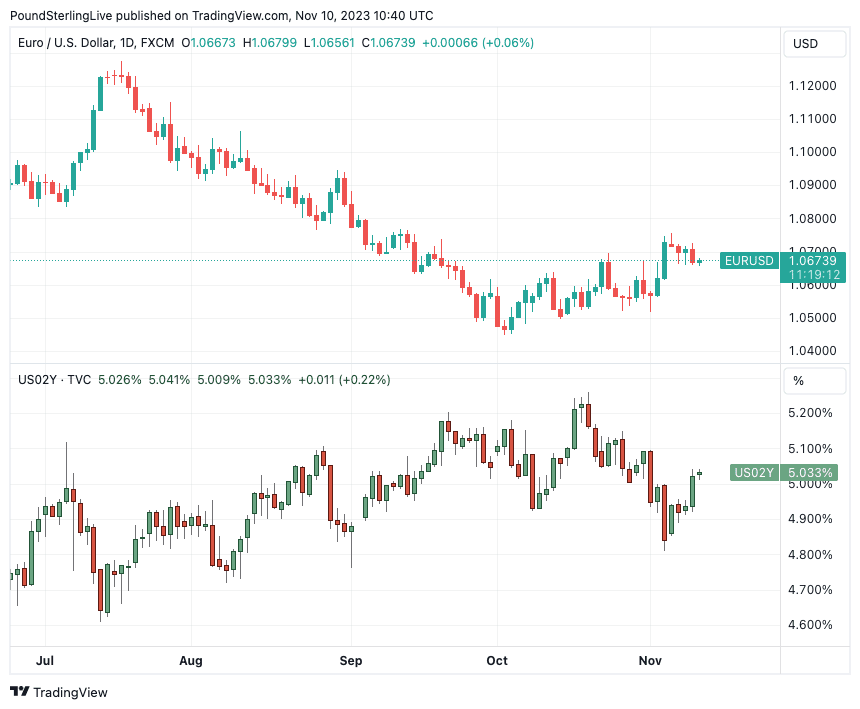Euro-Dollar Heads for a Weekly Decline on Concerted Fed Pushback: XM.com

Image © Adobe Images
The Euro to Dollar exchange rate looks on course to record a weekly decline thanks to coordinated guidance from a number of Federal Reserve officials.
Federal Reserve officials have been out in droves this week, highlighting the extraordinary strength of the U.S. economy and stressing that interest rates might need to be raised further to bring inflation back under control.
It appeared like a coordinated attempt by policymakers to steer market expectations.
This message was hammered home by Fed Chairman Powell yesterday, who stated that his central bank “will not hesitate” to tighten further if it becomes appropriate.
In a similar vein, he said the Fed is not confident yet that it has achieved sufficiently restrictive policy to defeat inflation.
Markets responded to these hawkish remarks in classic fashion - the dollar strengthened as US bond yields zoomed higher, boosting the reserve currency’s interest rate advantage.
A disappointing 30-year debt auction that saw extremely weak demand likely amplified these moves.
Above: Euro-Dollar at daily intervals (top) and U.S. two-year yields. Higher yields = lower EURUSD. Set up a daily rate alert email to track your exchange rate OR set an alert for when your ideal exchange rate is triggered ➡ find out more.
The focus now turns to next week’s CPI inflation report, which will shape bets around the interest rate path.
In the bigger picture, the question facing traders heading into next year is which central banks will cut rates first and how deep those cuts will be.
That’s a setup that favours the dollar, as the resilience of the U.S. economy suggests the Fed might be among the last ones to launch an easing campaign.
Shares on Wall Street lost some ground yesterday, feeling the heat of rising yields. Powell’s hawkish commentary managed to interrupt a winning streak of eight consecutive sessions for US stocks, with the S&P 500 getting rejected by a downtrend line to close 0.8% lower and erase all its gains for the week.
Equities were turbocharged by falling yields earlier this month, even though the earnings season has not been particularly impressive.
Sure, earnings growth surprised to the upside and is running at nearly 5% from last year, but that’s happening in an environment of 6% nominal GDP growth.
This begs the question of how corporate earnings will fare once the economy loses steam, making the consensus estimate of 12% earnings growth for next year seem unrealistic.
Over in the UK, a positive surprise in quarterly GDP data was not enough to lift the pound. The UK economy stagnated in the third quarter, overcoming forecasts pointing to a minor contraction.
However, business investment fell off a cliff, which, in conjunction with gloomy business surveys, suggests that the worst is yet to come for the British economy.
The strangest part of yesterday’s session was that gold prices traded higher despite the negative pressure exerted by rising real yields and an appreciating US dollar. Since the precious metal doesn’t pay any interest to hold, it becomes less attractive as yields rise.
Similarly, because gold is denominated in US dollars, a stronger dollar makes it more expensive to buy for foreign investors.
Therefore, it appears these negative forces for gold were overpowered by something even stronger - perhaps direct purchases by central banks raising their reserves. That said, gold prices are still headed for heavy weekly losses and the root cause might be the absence of a material escalation in the Middle East.
As horrific as the situation is, the conflict has not spiralled out of control to engulf the entire region.
Since this threat never materialised, it appears speculators have started to exit some of their long positions in gold that were meant to protect them from a conflagration in the war. The sharp decline in oil prices this week tells the same story.
As for the rest of today, the most noteworthy data release will be the University of Michigan consumer sentiment survey.
Article by Marios Hadjikyriacos, Senior Investment Analyst at XM.com. An original version can be viewed here.











